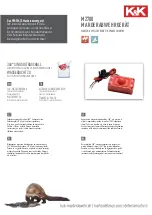
11 - 269 11 - 269
MELSEC-Q
11 INSTRUCTIONS AND FUNCTIONS
• Specify the devices to which data is to be written along with the data itself using
integer arrays for the number of points to be written in <storage area for data to be
written>.
(0)
(1)
(2)
Device code
Device number
Device code
%
When specifying the nth device point
((n - 1) 3)
%
Specify the device type using the defined code number.
See Section 4.2.5 for the code numbers.
((n - 1) 3 + 1)
%
Specify the device number of the specified device.
See Section 4.2.5 for the allowable specification range.
For example, when the number of points to be written is 2 points:
(0)
%
(1)
%
Device code
Device number
The specification for
the first point is
((1 - 1)
×
3 + 1)
((1 - 1)
×
3)
The specification for
the second point is
(3)
%
(4)
%
Device code
Device number
((2 - 1)
×
3)
((2 - 1)
×
3 + 1)
Device number
Data written
(3)
(4)
((n - 1) 3 + 2)
%
Specify the data written to the devices.
See Section 4.2.6 as well for how to specify data to be written.
(2)
%
Data written
((1 - 1)
×
3 + 2)
(5)
%
Data written
((2 - 1)
×
3 + 2)
×
×
×
• The following processing is performed if file registers are specified as the device
memory to which data is to be written:
(1) If the file registers have never been changed in the PLC CPU, data is written to
the file registers of block number 0.
(2) If the block number of the file registers has been changed in the PLC CPU, data
is written to the file registers of the new block number.
1) When the block number has been changed using the RSET instruction of the
microcomputer program package of the type SW GHP-UTLPC-FN1 utility
software package or the type SW SRX-FNUP software package
2) When the block number has been changed using the RSET instruction
Processing cannot be performed normally with processing code 3 if the block number of the file
registers has been changed to 29 or greater using the RSET instruction. In this case, use
processing code 6 (random writing to extension file registers) instead.
















































